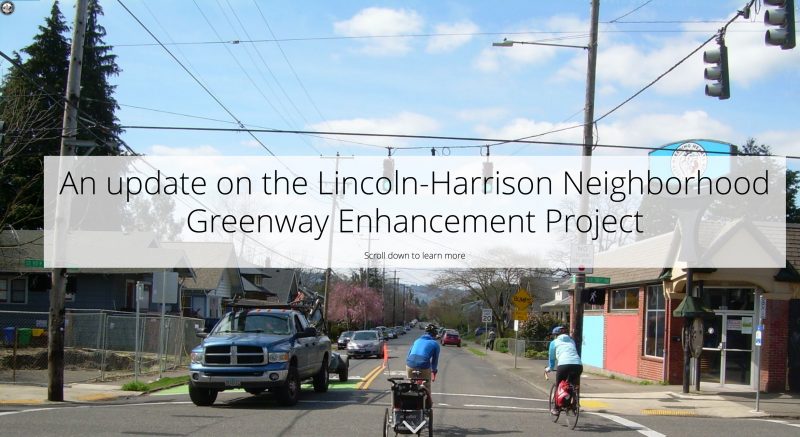
After hundreds of comments, dueling online petitions, and a now-legendary open house that devolved into a “mob scene” takeover, the City of Portland has emerged with a new approach to the Lincoln-Harrison Neighborhood Greenway Enhancement Project.
They have altered their initial plans and — in an effort to assuage naysayers of certain elements of the old plan — have redoubled their efforts to effectively communicate the need for the project in general.
To answer critics who question the need for improving bike access while making auto access less convenient, the Bureau of Transportation (PBOT) brought out key facts and policy statements we wish they’d be more aggressive with more often. Dusting off a provocative graphic, they said if we don’t shift more people to non-driving modes Portland will need 23 Powell Boulevards criss-crossing every neighborhood in the city to handle traffic by 2025. They also published the statement: “Investments in bicycle transportation provide the city’s best return on investment in personal mobility.”
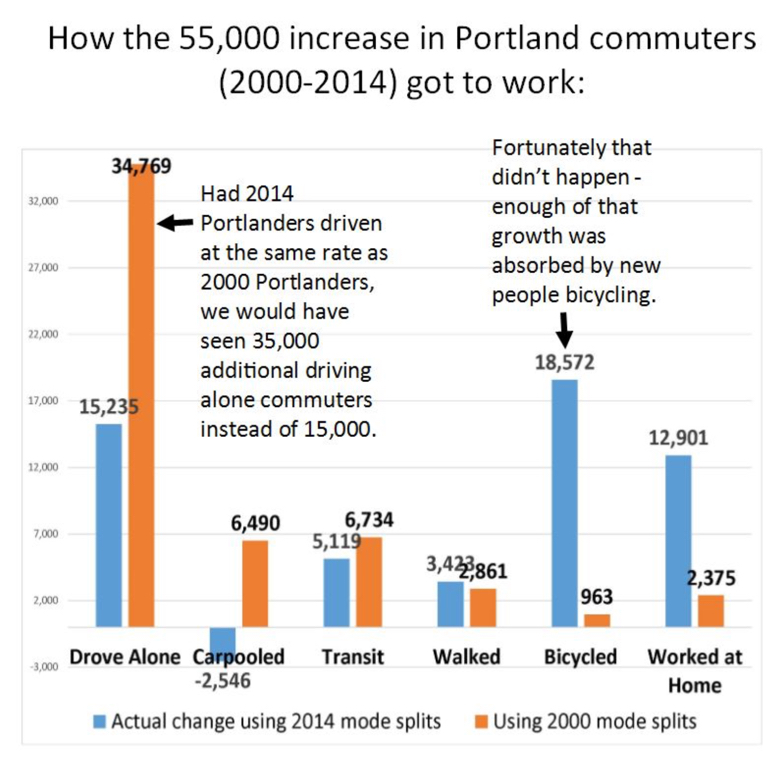
And then they used this common sense and reasonable — yet very powerful — justification: “For a range of reasons, Portland has decided it would be better to design for and encourage more walking, biking, and transit use than to build enough roadway capacity to ease increased driving. Climate change, congestion, individual health, community health, and environmental health are a few of these reasons.”
Let’s quickly revisit how we got here:
Advertisement
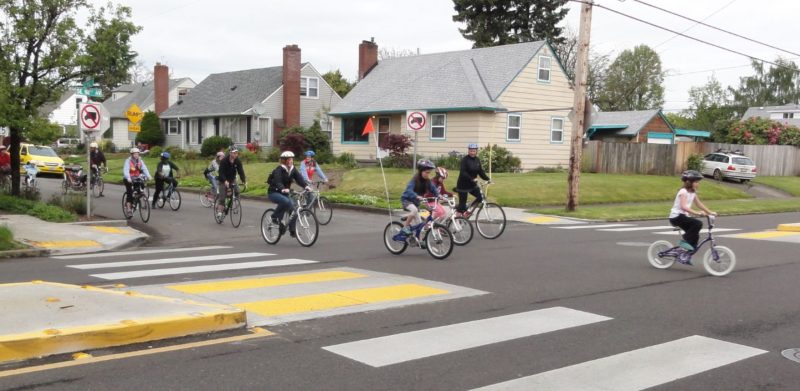
(Photo taken from PBOT’s new presentation)
Lincoln-Harrison is one of Portland’s original “bike boulevards” (now called neighborhood greenways) and the Bureau of Transportation (PBOT) is taking a hard look at it due to the increase in the number of people who drive on it — too many of whom drive at unsafe speeds. As they recently did with Southeast Clinton, PBOT went to their neighborhood greenway toolkit and announced a series of changes last October aimed at making the street safer. The plan included speed bumps, safer crossings, and median traffic diverters aimed at limited access to certain blocks at certain intersections.
It’s those diverters that attracted the most negative reaction from some local residents. A diverter planned for Lincoln at 50th would have completely prevented people from turning onto Lincoln. After pushback, PBOT has now decided on a new diverter design that allows right turns onto Lincoln from 50th. A “low-cost” diverter median will be installed this spring on an interim basis so PBOT can begin to collect traffic data.
On a related front, people also expressed concerns that if too many drivers were diverted off Lincoln, other streets would fill up. PBOT says the new interim diverter will give them the data they need to assess impacts and consider traffic calming measures on other streets if necessary. The City will also move forward with eight new speed bumps on SE Hawthorne between 50th and 60th to address concerns that drivers will simply cut-through on that street instead.
The entire new plan has been released in what I think is a first for PBOT: a slick “story map” that significantly ups their communication game. And so far the response to the new plan from the Bike Loud PDX email list is positive and cautiously optimistic.
The project is now full-steam-ahead with diverters at Lincoln and 50th due to be installed this spring and the rest of the project — which includes diverters at SE 26th and 30th — slated for construction this summer. The project should be all wrapped up with new signage and striping by late fall of this year.
Get up to speed with all the details by scrolling through the new Story Map and reading the updated FAQ page.
— Jonathan Maus: (503) 706-8804, @jonathan_maus on Twitter and jonathan@bikeportland.org
Never miss a story. Sign-up for the daily BP Headlines email.
BikePortland needs your support.


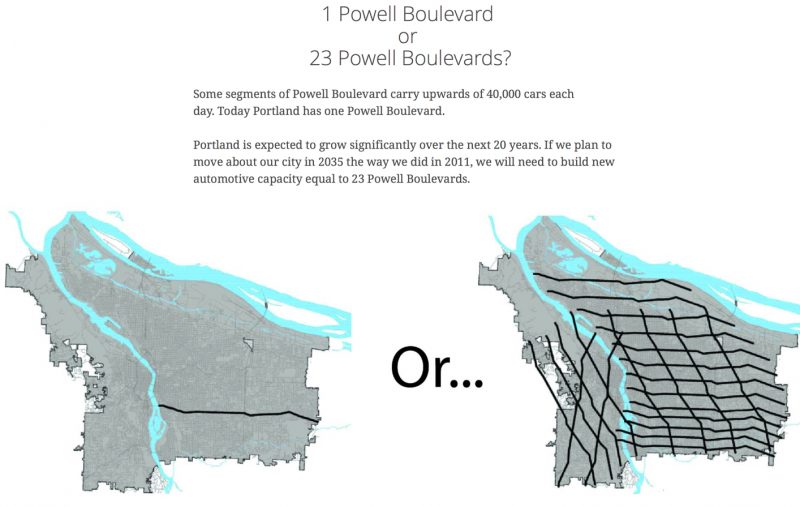

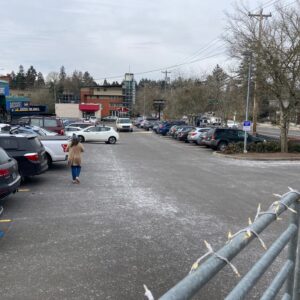

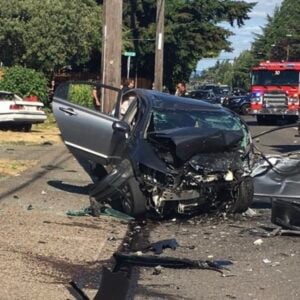
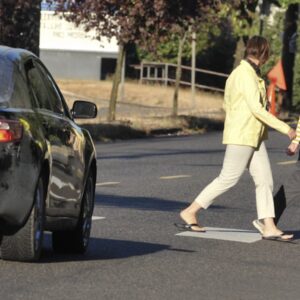
Thanks for reading.
BikePortland has served this community with independent community journalism since 2005. We rely on subscriptions from readers like you to survive. Your financial support is vital in keeping this valuable resource alive and well.
Please subscribe today to strengthen and expand our work.
“Investments in bicycle transportation provide the city’s best return on investment in personal mobility.”
Better late than never. I love it when PBOT talks tough 😉
It is great to see this!
However, these numbers are also scary. 23 * 40,000 = 920,000. This means that PBOT expects almost 1 million more people to drive in Portland by 2035 if the travel mode does not change. Shifting 1 millions people from driving cars to other modes of transportation would be a truly systemic change that requires large, comprehensive infrastructure actions. Absent such actions, we’ll see a lot more driving on Portland streets — and not just Powell but many neighborhood streets because main arterials are already at capacity during rush hour.
“numbers are also scary.”
Indeed, and thank you for pointing that out. This is what you/we get for falling into a codependent relationship with growth all these years.
That is hardly the whole story. These things don’t just happen to us (unless we assume that and in so doing help it to be so). We could also decide to have a conversation about population growth, its pros and cons, and how to get a handle on it.
The challenge is to take it seriously, shop it around, inspire others to grapple with the implications. If we wait around for someone else to make it happen it is probably going to be too late.
Except US population growth is not due to birth rates, but due to immigration. So if you want to have that conversation having it with your friends is really moot, since we are not reproducing at a rate to maintain our population, better it be a global conversation.
yes and no.
We all play roles, could take a stand, advance the conversation (compassionately).
People generally do not react well when someone lecturing them about changing a behavior have done that behavior themselves. Those frequently make for great encounters.
“I’ve had 3 kids, but you should only have 1.”
I agree. Do you know something about my fecundity that I don’t?
The question is: now that the low hanging fruit has been eaten (inner neighbourhoods redeveloped)…how can PBoT keep future commuters out of their cars once they get into them, now that they are commuting from North Vancouver (ala Ridgefield) and the outer tier of MultCo where new housing ($300k entry) is being “planted”?
Much development is still going on, and will continue to, in Inner Neighborhoods. To capture more population where it is very feasible to bike, the city should be encouraging this. Certainly the outer neighborhoods will grow, as well, but because of the distances to jobs, the sparsity of a street grid, overly wide streets, and unfriendly sidewalks, residents in those neighborhoods will rely on the car more heavily than those in inner neighborhoods. Inner neighborhood zoning must be looked at more critically to fully utilize “high opportunity” neighborhoods, as well as trying to create new ones.
Yes, but why this project in particular in this area, when there is so much needed in SW, North, and East Portland?
Could it be that the city staff are not disinterested parties in all this, but do in fact live in this particular area, and are therefor are community stakeholders themselves?
Wow. You sound like a resident of LHL.
You apparently didn’t even bother to visit the website.
Getting to 25% mode share requires investment all over. East Portland is only going to get to about 6% in the near term. Boosting inner areas that are already above 15-20% into the 40% range is how the city average is going to get to 25%.
paikiala, where can we find the detailed data on commuting demographics and mode by area of the city?
Paikiala, I’m glad you find I still sound like an ignorant local, especially since I lived in Portland for 18 years and have been gone for a very long 2 years. I very much doubt that as poorer Portland bicycle users continue to get priced-out of the inner parts of the city that you’ll see a 40% mode share any time in the next 20 years there, but with a few strategic investments in the outer parts of the city, a 15% mode share in East Portland is distinctly possible, especially when 45% of the city residents will be living there by 2040 given past and current trends and a usual lack of leadership by City Hall.
“I very much doubt […] that you’ll see a 40% mode share any time in the next 20 years”
Oh, we will. Mark my words. ;-(
It’s a fundamental geometry problem. East Portland is too far away from downtown to every have a large modal share. The Springwater is pretty much an ideal bike route into downtown Portland. Why aren’t we seeing bike-friendly condos popping up all the way out to Gresham? It’s the distance. Only hardcore commuters will do 10+ mile commutes. And yes, I’m aware that there are a lot of jobs in east Portland (I have one of them), but the majority of the employment opportunities are central to Portland.
The lower cost housing development activity in Portland is in East Portland and other “further out” areas outside of “inner” Portland. We need to make those areas friendly for biking and ped/transit. Otherwise, Portlanders living in EaPo will drive to work, and they will drive through inner Portland on their way to downtown, meaning inner Portland streets will be overwhelmed with car traffic, which will reduce bike mode even in inner Portland, regardless of the investment in bike infrastructure on those inner Portland streets.
East Portlanders generally don’t work downtown, but rather along the Columbia Corridor, Swan Island, Gresham, and other industrial areas, but yes, you are right, as the city frees up traffic capacity, it will be filled with downtown commuters from Clark and Clackamas counties.
I wonder if that won’t be changing as more Portlanders move into EaPo.
Incorrect. I live near I-205 and commute by bike to my downtown job every day. Many of my neighbors do the same. A lot of us use the Lincoln / Harrison and Clinton / Woodward Greenways.
Generalizations are just that– East Portland is way more diverse than you think. If you lived here, you might know that.
The Planning and Sustainability Bureau did a study about 5 years ago that found only about 8% of East Portland workers worked downtown, but that well over half worked in the Columbia Corridor, the airport, or Swan Island, with most of the rest in other industrial areas of the metro area. Do keep in mind that most commuters in Portland, and especially in East Portland, drive to work (and pretty much everywhere else, alas.) I agree, as the rest of Portland becomes increasingly expensive, that percentage will change, but not nearly as fast as you might think.
And by the way, I lived in East Portland, near Sayler’s Country Kitchen, for 8 years and served on the Hazelwood NA Board & EPAP for 6 years, so I do “know” East Portland pretty darn well. I’ve only been out of town for the last two years, in exile in NC.
“The lower cost housing development activity in Portland is in East Portland”
East Portland has seen sharp increases in the price of rent and lacks the infrastructure to support ~60,000 needed affordable housing units (Metro Housing Snapshot). On the other hand, sparsely populated neighborhoods like Laurelhurst and Sunnyside have large amounts of excess capacity for affordable rental housing.
I agree that East Portland doesn’t have the infrastructure to support 60,000 more units, since it doesn’t have the infrastructure to support even half the population it has now. It is completely dysfunctional. However, as long as the City of Portland has a weak central government and a bureaucracy that doesn’t care, the market will continue to push housing where land is cheapest and neighborhood resistance is weakest, which is still East Portland, and will likely continue for some decades yet.
Yes…and this is awful.
I’ve spoken with three of the candidates for Saltzman’s seat (Williams, Valderrama, and Hardesty) and they all support to some degree changing to a strong mayoral system with district representatives. Valderrama and Hardesty at least live in east Portland, and Williams doesn’t own a car.
It’s a good race to get involved in.
I’ve worked with both Valderrama and Hardesty in the past and highly respect them. I hope one of them gets elected. I don’t recall meeting Williams before I left Portland.
The PBOT graphic is either unclear or misleading. Portland’s entire population is not even 1 million. There will not be a need for 23 more Powell Blvds to carry 1 million additional drivers, even if modes don’t change.
I applaud PBOT’s efforts to better communicate the need for improved cycling routes. But this graphic oversells it, at the risk of credibility.
I believe it’s number of additional trips, not drivers. Portland is projected to add 260,000 new residents by 2040, around 100,000+ new households. The average Portland metro household generates about 9 trips a day. When you factor in the growth in other parts of the region, a million new car trips doesn’t sound far-fetched.
The 1 million figure may include workers from other communities who commute to jobs in Portland on a regular basis. Major downtowns like New York and London have numbers of daily workers who commute that are many times their residential population.
I’m glad to see that PBOT improved their messaging to explain why the diverters and speed bumps are needed on Lincoln/Harrison, as well as elsewhere.
PBOT needs to learn to bring their best game to the FIRST meeting, rather than having to be reactionary as if they weren’t expecting it…
Very powerful graphics…showing what we all have known for 10 years…that bicycling has out performed TRIMET (2000 to ~2014)…
…and that does not even get to comparing the investment $ in transit vs. bike $ (even counting for the transit investment that supported bikeway roadway upgrades).
[I would love to see any PSU study that has studied this relationship in more detail vs. my gut instinct.]
To have Powell Blvd sidewalks in SW, that would be an upgrade for many roads.
Not to mention for outer Powell itself!
Here’s the problem at SE Harrison and 26th – PBOT is still proposing to do nothing on adjacent streets to manage the traffic that currently accesses SE Harrison westbound at SE 26th and will otherwise be diverted into the neighborhood by this project.
This traffic is going to filter/divert into the neighborhoods on SE 26th north of SE Harrison and on other westbound streets (Lincoln, Grant, Sherman, Carruthers) east of 26th south of Harrison.
This traffic needs to be calmed on SE 26th between Division and Harrison, e.g. with speed tables, or be diverted from entering the neighborhood at SE 26th and Division.
All the focus so far has been on SE 50th and PBOT has done nothing to address the issues at SE 26th and Harrison.
That’s my $0.02 as a homeowner in this neighborhood.
It’s those damn GPS units in everyone’s car – they route drivers to use the least congested street to get around, which is usually a local side street.
Sounds like a wise use of infrastructure and existing capacity, no?
Efficient, certainly. Wise? I doubt it.
You should share your crystal ball with PBOT.
does a renter who lives in montavilla or east portland and uses this major bikeway to get to their job matter less than a:
However, unlike the homeowners at SE 50th and Lincoln, who seem more concerned about their own automobility, my primary concern is that a significant portion of the diverted traffic will end up on my street, in front of my house, and PBOT will have declared success and washed their hands of any unintended consequences by that point in time. Maybe you should get a grip and go a bit easier on the stereotyping???
Thank you for drawing attention to the problems on 26th. We live half a block off of this street and have witnessed a considerable increase in traffic. For several years at least three families on our block have independently contacted the city through various channels to ask for speed bumps, a stop sign, and pedestrian crossings – there is a school with a large field that supports community activities a 1/2 block off of 26th. With the stop light at Division and hill up to Harrison but without a stop sign in between cars seem to be racing either up or down the street. Is it typical to have so many consecutive blocks in se Portland without a single stop sign?
Why remove the 31 speed bumps on Lincoln west of 50th? That is a gift to drivers who cut through to Lincoln off neighborhood streets and gives them a straight shot.
I think you read that wrong. They are adding 31, and removing 5.
From the site: “Fixed cameras only allowed on high crash corridors, like Barbur” I hope in this case PBOT is forecasting the actual installation of speed cameras on Barbur, since currently there are none installed. Perhaps this is just a reminder to ODOT to “Fix Barbur Blvd”?